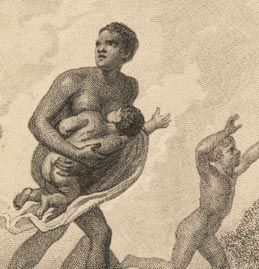
Origins of Abolitionism
![]()
The Slave Trade Act did not render slavery itself illegal, however, and
abolitionists in England still faced many years of struggle. In 1824,
the abolitionist Elizabeth Heyrick (1769-1831) challenged the prevailing
“gradualism,” or support for a gradual end to slavery, when
she published the pamphlet Immediate, not Gradual Abolition. Her call
for an immediate end to slavery, accepted in most female abolitionist
organizations, was widely resisted in the more powerfully connected, male-dominated
societies. Through persuasion and political maneuvering, however, Heyrick’s
ideas gained ground, and abolitionist leadership finally embraced “immediatism.”
After decades of battle in Parliament against powerful proslavery lobbies, British abolitionists finally realized their ultimate goal. In 1833, the Abolition of Slavery Act was passed, initiating a plan to free all slaves over the next four years and to compensate slave owners financially for their “property” losses.
The abolitionists’ victory in Britain did not go unnoticed in America. While continuously publishing British anti-slavery materials, American activists celebrated and commemorated West Indian emancipation, knowing that the same could—and would—be achieved in the United States.
![]()
| |
| |
| |
| |
| |
| |
| |
| |
| |
| |
| |
| |

Copyright
© 2002 Division of Rare & Manuscript
Collections
2B Carl A. Kroch Library, Cornell University, Ithaca, NY, 14853
Phone Number: (607) 255-3530. Fax Number: (607) 255-9524
For
reference questions, send mail to:
rareref@cornell.edu
For questions or comments about the site, send mail to: webmaster.